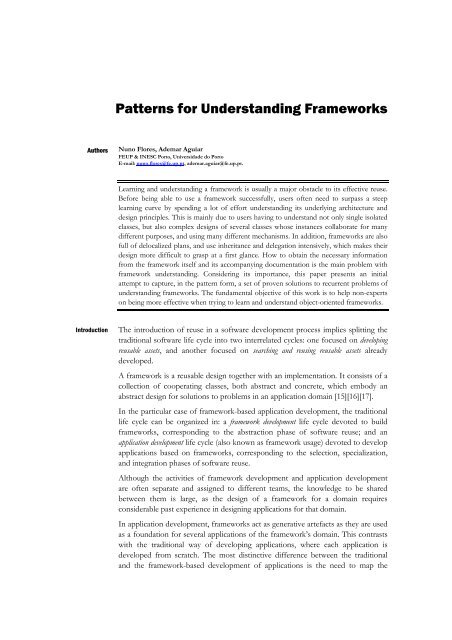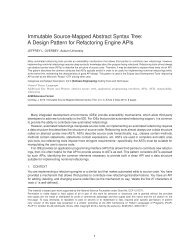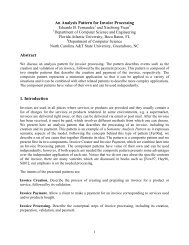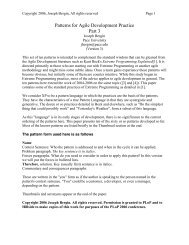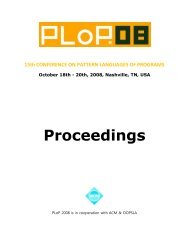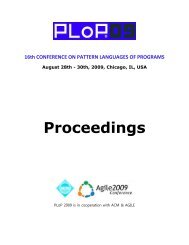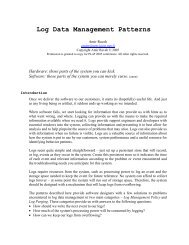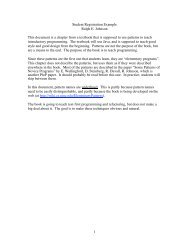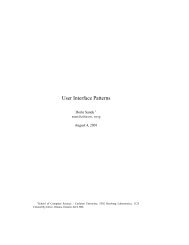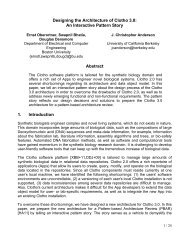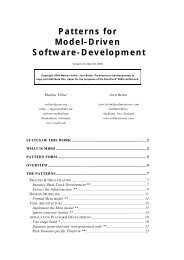Patterns for Understanding Frameworks - The Hillside Group
Patterns for Understanding Frameworks - The Hillside Group
Patterns for Understanding Frameworks - The Hillside Group
You also want an ePaper? Increase the reach of your titles
YUMPU automatically turns print PDFs into web optimized ePapers that Google loves.
Authors<br />
Introduction<br />
<strong>Patterns</strong> <strong>for</strong> <strong>Understanding</strong> <strong>Frameworks</strong><br />
Nuno Flores, Ademar Aguiar<br />
FEUP & INESC Porto, Universidade do Porto<br />
E-mail: nuno.flores@fe.up.pt, ademar.aguiar@fe.up.pt.<br />
Learning and understanding a framework is usually a major obstacle to its effective reuse.<br />
Be<strong>for</strong>e being able to use a framework successfully, users often need to surpass a steep<br />
learning curve by spending a lot of ef<strong>for</strong>t understanding its underlying architecture and<br />
design principles. This is mainly due to users having to understand not only single isolated<br />
classes, but also complex designs of several classes whose instances collaborate <strong>for</strong> many<br />
different purposes, and using many different mechanisms. In addition, frameworks are also<br />
full of delocalized plans, and use inheritance and delegation intensively, which makes their<br />
design more difficult to grasp at a first glance. How to obtain the necessary in<strong>for</strong>mation<br />
from the framework itself and its accompanying documentation is the main problem with<br />
framework understanding. Considering its importance, this paper presents an initial<br />
attempt to capture, in the pattern <strong>for</strong>m, a set of proven solutions to recurrent problems of<br />
understanding frameworks. <strong>The</strong> fundamental objective of this work is to help non-experts<br />
on being more effective when trying to learn and understand object-oriented frameworks.<br />
<strong>The</strong> introduction of reuse in a software development process implies splitting the<br />
traditional software life cycle into two interrelated cycles: one focused on developing<br />
reusable assets, and another focused on searching and reusing reusable assets already<br />
developed.<br />
A framework is a reusable design together with an implementation. It consists of a<br />
collection of cooperating classes, both abstract and concrete, which embody an<br />
abstract design <strong>for</strong> solutions to problems in an application domain [15][16][17].<br />
In the particular case of framework-based application development, the traditional<br />
life cycle can be organized in: a framework development life cycle devoted to build<br />
frameworks, corresponding to the abstraction phase of software reuse; and an<br />
application development life cycle (also known as framework usage) devoted to develop<br />
applications based on frameworks, corresponding to the selection, specialization,<br />
and integration phases of software reuse.<br />
Although the activities of framework development and application development<br />
are often separate and assigned to different teams, the knowledge to be shared<br />
between them is large, as the design of a framework <strong>for</strong> a domain requires<br />
considerable past experience in designing applications <strong>for</strong> that domain.<br />
In application development, frameworks act as generative artefacts as they are used<br />
as a foundation <strong>for</strong> several applications of the framework’s domain. This contrasts<br />
with the traditional way of developing applications, where each application is<br />
developed from scratch. <strong>The</strong> most distinctive difference between the traditional<br />
and the framework-based development of applications is the need to map the
<strong>Patterns</strong> <strong>for</strong> <strong>Understanding</strong> <strong>Frameworks</strong> 2<br />
structure of the problem to be solved onto the structure of the framework, thereby<br />
<strong>for</strong>cing the application to reuse the design of the framework. <strong>The</strong> positive side of<br />
this is that we don’t need to design the application from scratch. But, on the other<br />
hand, be<strong>for</strong>e starting application development, we need to understand the<br />
framework design, a task that sometimes can be very difficult and time-consuming,<br />
especially if the framework is large or complex, and is not appropriately<br />
accompanied with good documentation or training material.<br />
designing and<br />
Domain<br />
implementing<br />
Framework<br />
framework<br />
developer<br />
evolving<br />
Applications<br />
applying<br />
Documentation<br />
Figure 1 - Activities, artefacts and roles of framework-based application development.<br />
Figure 1 shows a simplified view of framework-based application development that<br />
relates the artefacts, activities, and roles most relevant <strong>for</strong> the topic of the patterns<br />
presented in this paper – framework understanding. Because understanding<br />
frameworks is of major importance <strong>for</strong> application developers, in the figure, the<br />
activity is assigned exclusively to that role, but in fact it can be also relevant <strong>for</strong><br />
framework selectors, original framework developers (especially of large<br />
frameworks), framework maintainers, and developers of other frameworks,<br />
although not with the same degree of importance.<br />
In relation to the other activities depicted, there are pattern languages addressing<br />
their own challenges and problems, of which we refer “Evolving frameworks: A pattern<br />
language <strong>for</strong> developing object-oriented frameworks” [1], regarding design, implementation<br />
and evolution activities, and also “<strong>Patterns</strong> <strong>for</strong> Documenting <strong>Frameworks</strong>” [2][3][4],<br />
regarding documentation activities.<br />
<strong>The</strong>re<strong>for</strong>e, this paper contributes patterns to a pattern language focusing on<br />
problems of understanding frameworks (white-box, black-box or gray-box), which<br />
must be properly managed be<strong>for</strong>e being able to use frameworks effectively.<br />
White-box frameworks rely heavily on inheritance and dynamic binding in order to<br />
achieve extensibility. Although white-box reuse is the hardest way to use a<br />
framework, it is by far the most powerful.<br />
Copyright © 2008, Nuno Flores ,Ademar Aguiar. All rights reserved. Permission granted to copy <strong>for</strong> all purposes of PLoP’2008<br />
refining<br />
documenting<br />
understanding<br />
understanding<br />
application<br />
developer<br />
artefact activity role role-assignment
<strong>Patterns</strong> <strong>for</strong> <strong>Understanding</strong> <strong>Frameworks</strong> 3<br />
Pattern language<br />
Black-box frameworks are the easiest to use, because they are structured using<br />
object composition and delegation rather than inheritance. On the other hand,<br />
black-box frameworks are the most difficult to develop, because they require the<br />
definition of the right interfaces and hooks able to anticipate a wide range of<br />
application requirements.<br />
Most real-world frameworks combine black-box and white-box characteristics,<br />
being thus called gray-box frameworks. <strong>The</strong>y allow extensibility both by using<br />
inheritance and dynamic binding, as well as by defining interfaces. Gray-box<br />
frameworks are designed to avoid the disadvantages of black-box frameworks and<br />
white-box frameworks.<br />
Although some of the problems here addressed could also be common to large or<br />
complex software systems, frameworks are specifically designed to be easy to reuse,<br />
thus adding special needs from the point of view of learning and understanding.<br />
<strong>The</strong> pattern language comprises a set of interdependent patterns aiming to help<br />
users become aware of the problems that they will typically face when starting to<br />
learn and understand frameworks. <strong>The</strong>se patterns are targeted <strong>for</strong> framework users<br />
especially novices. <strong>The</strong> patterns were mined from existing literature, lessons<br />
learned, and expertise on using frameworks, based on previous studies and<br />
literature reviews of the authors on the topic [5][6].<br />
<strong>The</strong> pattern language outlines a path commonly followed when learning and<br />
understanding a framework. As many frameworks can be very difficult to learn and<br />
understand, completely or in detail, these patterns aim to expose the tradeoffs<br />
involved in the process of understanding a framework, and to provide practical<br />
guidelines on how to balance them to find the best learning strategy <strong>for</strong> each<br />
specific person (learner or framework user) and context.<br />
<strong>The</strong> problems addressed by the patterns are basically raised by the following<br />
questions:<br />
• What do I need to understand about the framework to accomplish my<br />
task? What kind of knowledge do I need? More concrete or abstract? At<br />
code level, design level, documentation level?<br />
• How can I acquire the knowledge I need? Which learning strategy should I<br />
adopt? Which one is best <strong>for</strong> my needs?<br />
• Which kinds of tools can I use to gather, organize, explore and preserve<br />
the knowledge I value most?<br />
According to [14], framework reuse can be divided into categories according to the<br />
re-user’s interests, whether a framework selector, an application developer, a<br />
framework maintainer, or a developer of other frameworks. <strong>The</strong>se categories range<br />
from selecting, instantiating, flexing, composing, evolving and mining a framework.<br />
For the scope of the pattern language presented in this paper, only the most<br />
commonly used will be addressed: selecting, instantiating and evolving.<br />
Copyright © 2008, Nuno Flores ,Ademar Aguiar. All rights reserved. Permission granted to copy <strong>for</strong> all purposes of PLoP’2008
<strong>Patterns</strong> <strong>for</strong> <strong>Understanding</strong> <strong>Frameworks</strong> 4<br />
<strong>Patterns</strong> overview<br />
To describe the patterns, we have adopted Christopher Alexander's pattern <strong>for</strong>m:<br />
Name-Context-Problem-Solution-Consequences [7]. We’ve also added a Rationale section<br />
and a See also section, where known uses and further reading directions can be<br />
found. Be<strong>for</strong>e going to the details of each pattern, we will briefly overview the<br />
pattern language with each pattern’s intent and a map (Figure 2) showing their<br />
relationships.<br />
Usually<br />
precedes<br />
Instantiating a<br />
framework<br />
Benefits from<br />
experience of<br />
Evolving a<br />
framework<br />
Selecting a<br />
framework<br />
How to use<br />
the framework?<br />
How to choose<br />
a framework ?<br />
How to evolve<br />
the framework?<br />
What is the<br />
domain scope?<br />
Drive your<br />
learning<br />
What are the<br />
main components?<br />
How is the<br />
flexibility supported ?<br />
How is it<br />
implemented?<br />
Understand the<br />
application domain<br />
Captures context<br />
Captures the<br />
high-level design<br />
Understand the<br />
architecture<br />
Details<br />
the architecture<br />
Focus on<br />
the hot-spots<br />
Understand the<br />
design internals<br />
Captures intermediate<br />
design concepts<br />
Understand the<br />
source code<br />
Implementation<br />
details<br />
preserve your<br />
knowlegde<br />
preserve your<br />
knowlegde<br />
Figure 2 – Framework understanding patterns and their relationships.<br />
preserve your<br />
knowlegde<br />
preserve your<br />
knowlegde<br />
Knowledge<br />
-keeping<br />
Selecting a framework. This pattern allows deciding whether or not to select a<br />
framework, after evaluating its appropriateness <strong>for</strong> an intended application<br />
domain.<br />
Instantiating a framework. This pattern shows how to learn about instantiating a<br />
framework in order to implement an application.<br />
Evolving a framework. This pattern shows what steps should be taken to learn how to<br />
evolve a framework.<br />
Drive your learning. This pattern shows how to plan your learning process throughout<br />
the task of understanding a framework.<br />
Knowledge-keeping. This pattern shows how to preserve the acquired knowledge<br />
about a framework.<br />
Understand the application domain. This pattern enables the learner to know what is the<br />
application domain covered by the framework.<br />
Understand the architecture. This pattern shows the learner how to find architectural<br />
knowledge about the framework.<br />
Understand the design internals. This pattern tells the learner how to look <strong>for</strong> knowledge<br />
about the design internals of the framework.<br />
Understand the source code. This pattern helps to understand how to identify where in<br />
the source code are the important parts that enable the developer to implement the<br />
application.<br />
When referring to a related pattern within this pattern language, its name will<br />
appear in SMALLCAPS. Otherwise, if it’s an “outside” pattern, it will appear in<br />
SMALLCAPS ITALICISED together with the respective reference.<br />
Copyright © 2008, Nuno Flores ,Ademar Aguiar. All rights reserved. Permission granted to copy <strong>for</strong> all purposes of PLoP’2008
<strong>Patterns</strong> <strong>for</strong> <strong>Understanding</strong> <strong>Frameworks</strong> 5<br />
Pattern Selecting a framework<br />
Problem<br />
Forces<br />
Solution<br />
Consequences<br />
Rationale<br />
You are someone (manager, project leader, developer) who is responsible <strong>for</strong><br />
finding a solution <strong>for</strong> an application development project in a certain domain.<br />
You are about to select a framework that can help you to solve your problem.<br />
Framework selection consists of deciding whether to reuse or not a framework,<br />
after evaluating its appropriateness <strong>for</strong> an intended application in a specific domain.<br />
What do you need to learn about a framework in order to select it effectively?<br />
Ef<strong>for</strong>t. You don’t want to spend too much time learning what you need to know to<br />
effectively decide if a framework is selectable.<br />
Certainty/Sureness. You need to be sure that the framework you’re about to select<br />
covers, not only your application domain, but also all of your specific needs.<br />
Documentation. <strong>The</strong> existing documentation may not give the necessary insight into<br />
the applicability of the framework.<br />
Complexity. <strong>The</strong> more complex a framework is, the harder it is to understand.<br />
Start by quickly understanding the framework under consideration. Look <strong>for</strong> a<br />
short description of the framework's purpose, the domain covered, and an<br />
explanation of its most important features, preferably illustrated with examples.<br />
In order to ascertain if a specific framework covers your domain requirements, you<br />
need to UNDERSTAND THE APPLICATION DOMAIN in a clear way, i.e., the<br />
domain covered by the framework, and the range of solutions <strong>for</strong> which the<br />
framework was designed and is applicable.<br />
However, knowing the purpose of the framework is not always enough to ensure<br />
that all the problems may be met by this framework. It can be important to go<br />
deeper to UNDERSTAND THE ARCHITECTURE, UNDERSTAND THE DESIGN<br />
INTERNALS, or UNDERSTAND THE SOURCE CODE, until being sure of the<br />
framework’s appropriateness <strong>for</strong> the problem at hand.<br />
To be more effective, you may consider to DRIVE YOUR LEARNING according to<br />
your experience and specific requirements.<br />
Cost-effectiveness. You quickly gain insight into the scope of the framework and its<br />
coverage of your specific needs. Going into detail gives you more accurate hints on<br />
how the framework is built and addresses your problems.<br />
Narrow knowledge. Yes, it solves your specific problems, but that doesn’t give you a<br />
whole grasp over what other specific problems it might address. Further<br />
investigation might be needed when new contextual-related problems arise.<br />
When using frameworks, one of the key decisions that need to be made is whether<br />
or not the framework fits the application. Since frameworks can be complex,<br />
Copyright © 2008, Nuno Flores ,Ademar Aguiar. All rights reserved. Permission granted to copy <strong>for</strong> all purposes of PLoP’2008
<strong>Patterns</strong> <strong>for</strong> <strong>Understanding</strong> <strong>Frameworks</strong> 6<br />
See also<br />
gaining a deep understanding of the framework to make that decision often<br />
requires the time consuming process of actually using the framework. Capturing<br />
in<strong>for</strong>mation about the applicable domain of the framework is a way to ease this<br />
decision [38]. Limitations and design trade-offs about the framework can help to<br />
show what the framework can and cannot be used <strong>for</strong>. <strong>The</strong>re will always be degree<br />
of uncertainty but that can be mitigated by existing documentation or the potential<br />
user will often per<strong>for</strong>m experiments to increase their understanding of the<br />
framework and to evaluate its appropriateness to the new application.<br />
In [18], Andrew Turner and Chao Wang had to evaluate a set of existing AJAX<br />
frameworks and select the most suited <strong>for</strong> their requirements. <strong>The</strong>ir process relied<br />
on ascertaining that all the frameworks could cover their specific domain and highlevel<br />
requirements. <strong>The</strong>y had to dig deeper into the framework internals and even<br />
develop some prototypes to test if the framework could address and solve their<br />
specific issues.<br />
In [19], Sheick et al. proposed and applied a criterion <strong>for</strong> ascertaining the suitability<br />
of a framework to a specific project. It relied on a set of areas to inspect, starting<br />
with the intended domain and evolving into detailed issues like the presence of<br />
design patterns and lower-level concerns such as error handling and degree of<br />
coupling. <strong>The</strong>y then applied their criteria to characterize an existing framework <strong>for</strong><br />
a transaction processing system implementation called jPOS ISO 8583, to see if it<br />
was suitable <strong>for</strong> selection.<br />
Copyright © 2008, Nuno Flores ,Ademar Aguiar. All rights reserved. Permission granted to copy <strong>for</strong> all purposes of PLoP’2008
<strong>Patterns</strong> <strong>for</strong> <strong>Understanding</strong> <strong>Frameworks</strong> 7<br />
Pattern Instantiating a framework<br />
Problem<br />
Forces<br />
Solution<br />
Consequences<br />
You have been given, or previously selected, a framework to use as a solution <strong>for</strong> a<br />
specific problem. You are now about to instantiate the framework in order to<br />
implement the intended functionalities and build your application.<br />
Framework instantiation usually consists on deducing, designing and implementing<br />
application-specific extensions to the framework. Despite knowing which<br />
extensions the framework requires, it is hard to understand where to “plug” those<br />
extensions in the framework.<br />
What do you need to learn about a framework in order to instantiate it quickly?<br />
Documentation. Tutorial documentation can help you to walkthrough the initial<br />
contact with the framework and to acquire knowledge about the framework’s entry<br />
points.<br />
Ef<strong>for</strong>t. You don’t want to spend too much time learning what you need to know to<br />
instantiate the framework.<br />
Learner’s experience. If you are already familiarized with the framework, you try to<br />
find similar areas of flexibility. A novice learner will look <strong>for</strong> demonstrating<br />
examples that might give her a hint of where to start poking the code <strong>for</strong> hot-spots.<br />
Complexity. Complexity may not mean “difficult to use”, but surely means “difficult<br />
to learn”. Issues like indirection, abstraction and obscurity give the framework its<br />
power but also hinder its ability to be learnt and understood.<br />
Find the areas of customization of the framework by looking at the existing<br />
documentation and resort to instantiation examples to clarify on how to use those<br />
areas.<br />
Look at the documentation to find the CUSTOMIZATION POINTS [4] of predefined<br />
refinement where framework instantiation is supported. In addition, look also into<br />
some GRADED EXAMPLES [3] that explain how to use the framework to<br />
implement more common functionalities. <strong>The</strong> customization of a framework is<br />
usually possible through sub-classing of framework abstract classes and/or<br />
composition of concrete classes. <strong>Understanding</strong> how these classes relate and<br />
interoperate is crucial to be able to use them properly.<br />
If you’re dealing with a white-box framework, it is important to further<br />
UNDERSTAND THE ARCHITECTURE and to UNDERSTAND THE DESIGN<br />
INTERNALS. Only then you can start to UNDERSTAND THE SOURCE CODE and<br />
effectively start reusing the framework.<br />
To be more effective, you may consider to DRIVE YOUR LEARNING according to<br />
your experience and specific requirements.<br />
Framework know-how. You gain knowledge on how to instantiate the framework,<br />
progressively increasing your expertise and being able to incrementally build your<br />
application.<br />
Copyright © 2008, Nuno Flores ,Ademar Aguiar. All rights reserved. Permission granted to copy <strong>for</strong> all purposes of PLoP’2008
<strong>Patterns</strong> <strong>for</strong> <strong>Understanding</strong> <strong>Frameworks</strong> 8<br />
Rationale<br />
See also<br />
Blind trust. Using a framework means trusting in code you have never seen. So if the<br />
framework is poorly built or has features that it publicizes but are not implemented<br />
or don’t work well, your solution may suffer with it. It’s not rare to see frameworks<br />
whose internal code is not available <strong>for</strong> debugging or modification.<br />
Framework instantiation into domain-specific application takes place at points of<br />
predefined refinement called hot-spots [20]. Thus knowing where and how to use<br />
these points leads to an effective framework instantiation. Moreover, [17]the best<br />
way to start learning a framework is by example [21]. Most frameworks come with<br />
a set of examples that you can study, and those that don’t are nearly impossible to<br />
learn. Examples are concrete, thus easier to understand than the framework as a<br />
whole. <strong>Frameworks</strong> are easier to learn if they have good documentation.<br />
In [10], Froelich et al. resort to a Hooks-model to describe the framework<br />
customization points and use it to instantiate the SEAF (Size Engineering<br />
Application Framework). <strong>The</strong>ir approach is similar to this as is relies on<br />
documentation describing the customization points (hooks) and uses it to know<br />
where to instantiate the framework.<br />
Copyright © 2008, Nuno Flores ,Ademar Aguiar. All rights reserved. Permission granted to copy <strong>for</strong> all purposes of PLoP’2008
<strong>Patterns</strong> <strong>for</strong> <strong>Understanding</strong> <strong>Frameworks</strong> 9<br />
Pattern Evolving a framework<br />
Problem<br />
Forces<br />
Solution<br />
Consequences<br />
You are a software engineer who is responsible <strong>for</strong> the maintenance and evolution<br />
of a framework. Your task may be to evolve the framework to support new<br />
requirements, refactoring its design, or the correction of errors, while preserving its<br />
backward compatibility.<br />
To evolve a framework means understanding where the evolution will take place<br />
within the framework and to which extent do you need to go. You need to know<br />
what elements to evolve and its impact on the framework as a whole.<br />
What do you need to learn to evolve a framework?<br />
Documentation. <strong>The</strong> documentation is almost always descriptive, which is not good<br />
<strong>for</strong> framework evolvers, because original framework designers can’t predict how<br />
the framework might be extended in the future through additional flexibility on<br />
existing hot spots, or in additional hot spots. A more prescriptive documentation<br />
would be better.<br />
Maintenance expertise. It is expected that the framework maintainers are both domain<br />
experts and software experts.<br />
Evolution task. Your task may be adding new functionalities or improving existing<br />
ones, correcting errors or refactoring the design. Different in<strong>for</strong>mation needs arise<br />
according to the task at hand.<br />
Tools. <strong>The</strong>re might be the need to recover lost design in<strong>for</strong>mation that is important<br />
to the evolution task. Existing reverse engineering tools may prove useful.<br />
Look at the architecture of the framework and understand how it is built and how<br />
it meets its purpose. Gain further insight of its components by looking at the<br />
design internals and areas of flexibility and treat each variability issue separately.<br />
Have a good UNDERSTANDing of THE ARCHITECTURE and its rationale, in order<br />
to avoid the architectural drift problem [22], commonly consequential of poor<br />
framework evolution. UNDERSTANDing THE DESIGN INTERNALS and<br />
UNDERSTANDing THE APPLICATION DOMAIN helps at keeping the evolution<br />
process in perspective. Look at the CUSTOMIZATION POINTS [4] that support the<br />
flexibility offered by the framework and plan you evolution tasks.<br />
To be more effective, you may consider to DRIVE YOUR LEARNING according to<br />
your experience and specific requirements.<br />
Evolution expertise. You gain enough insight to adequately address your evolution<br />
tasks. Be alert to issues regarding delta analysis, architectural drifts, version<br />
proliferation and over-featuring [22].<br />
Ignorant surgery. Evolving parts of the framework means understanding its interaction<br />
with its other parts. Sometimes, focusing too much on the problem at hand may<br />
cause what is called “ignorant surgery” [12]. Inadequate investigation prior to<br />
per<strong>for</strong>ming a change task limits the understanding of the existing design of a<br />
Copyright © 2008, Nuno Flores ,Ademar Aguiar. All rights reserved. Permission granted to copy <strong>for</strong> all purposes of PLoP’2008
<strong>Patterns</strong> <strong>for</strong> <strong>Understanding</strong> <strong>Frameworks</strong> 10<br />
Rationale<br />
See also<br />
system. <strong>The</strong> evolver per<strong>for</strong>ms a change in a single location in the code that is better<br />
understood, but which may lead to un<strong>for</strong>eseen effects throughout the framework<br />
as its dependencies aren’t properly identified and taken into account.<br />
<strong>The</strong> need to evolve a framework usually arises during any of the following<br />
situations: (1) new domain concepts need to be incorporated into the framework,<br />
(2) reducing the complexity of the framework through re-design and (3) initial<br />
design issues that were neglected need to be addressed [22]. <strong>The</strong> evolution process<br />
usually involves the execution of two tasks: restructure (refactoring) and extension. In<br />
order to restructure it properly, the developer must be aware of all the<br />
repercussions and dependencies of the components or customization areas she<br />
intends to extend or alter. Another concern is application compatibility. <strong>The</strong><br />
framework must remain compatible with earlier developed applications, whereas a<br />
faulty evolution process may change the way the framework is supposed to be<br />
used, closing otherwise opened customization points. By understanding how the<br />
framework is supposed to be used will enable the developer to maintain its<br />
interface coherent, without too much ef<strong>for</strong>t.<br />
In [1], Roberts and Johnson present a pattern language <strong>for</strong> evolving frameworks<br />
where they show that there is need <strong>for</strong> the understanding of different levels of<br />
detail concerning the framework components.<br />
In [39], Cortés et al. present a tool to support framework evolution tasks, namely<br />
refactoring and extension. <strong>The</strong>y propose to automate certain kinds of refactoring<br />
tasks and applying extension rules based on Pree’s meta-patterns, which implement<br />
variation points as a combination of template and hook methods.<br />
Copyright © 2008, Nuno Flores ,Ademar Aguiar. All rights reserved. Permission granted to copy <strong>for</strong> all purposes of PLoP’2008
<strong>Patterns</strong> <strong>for</strong> <strong>Understanding</strong> <strong>Frameworks</strong> 11<br />
Pattern Drive your learning<br />
Problem<br />
Solution<br />
Consequences<br />
You are about to learn a framework to reuse it. You have your understanding<br />
goals, but no process of learning to guide you through.<br />
Upon defining your learning goal, you need to start learning. Knowing what to<br />
learn is as important as reaching those goals through an effective learning process.<br />
Adopting a learning strategy is, there<strong>for</strong>e, essential. But what strategy is more<br />
suitable?<br />
How do you define the most effective process <strong>for</strong> your learning needs?<br />
Top-down vs. bottom-up. A top-down approach will start at a higher-level progressing<br />
downwards, giving a good overview with little ef<strong>for</strong>t but poor details. A bottom-up<br />
approach starts at a low-level progressing upwards, giving good detail with little<br />
ef<strong>for</strong>t, but hindering awareness of the global impact of changes.<br />
Learner’s experience. You experience with the framework can affect you learning<br />
strategy, when choosing where to start and how to proceed.<br />
Learning style. You may be a more “global”, “reflective” learner or you may possess a<br />
more “sequential”, “active” learning behaviour [13].<br />
Documentation. Depending on the existing documentation artefacts, the learner will<br />
have to adapt his learning strategy to quicker and better fill in her knowledge gaps.<br />
Select an entry point to start your understanding. Progress to the understanding<br />
level you feel more com<strong>for</strong>table with, changing directions whenever needed.<br />
A more experienced learner tends to adopt a more top-down approach, whereas a<br />
novice learner will go <strong>for</strong> a more bottom-up approach [25][26][27]. Remember you<br />
can start at any abstraction level. A “global”, “reflective” [24] learner will start at a<br />
higher level of abstraction and will “top-down” gradually into the framework,<br />
because she needs the big picture first. A “sequential”, more “active” learner will<br />
start at a lower-level, try things out and “bottom-up” into the framework, gathering<br />
bits and pieces to <strong>for</strong>m her mental model. <strong>The</strong>n, change directions, that is, swap<br />
strategies, as needed. This is beneficial to reduce cognitive overload and focus on<br />
the goal.<br />
Look at the DOCUMENTATION ROADMAP [2] and choose the documentation<br />
artefacts that may better assist you on your understanding tasks, namely<br />
FRAMEWORK OVERVIEW, GRADED EXAMPLES, CUSTOMIZATION POINTS,<br />
DESIGN INTERNALS and COOKBOOK & RECIPES [2][3][4].<br />
Methodical approach. A methodical investigation proves more effective than a chaotic<br />
one. By defining a course of action the chances of reaching an answer faster,<br />
increase.<br />
Personalized cognitive process. Navigate freely along the abstraction levels until you feel<br />
satisfied with the things you’ve learned. Your mental model will progressively<br />
increase throughout task execution.<br />
Copyright © 2008, Nuno Flores ,Ademar Aguiar. All rights reserved. Permission granted to copy <strong>for</strong> all purposes of PLoP’2008
<strong>Patterns</strong> <strong>for</strong> <strong>Understanding</strong> <strong>Frameworks</strong> 12<br />
Rationale<br />
See also<br />
On the field of Program Comprehension, many researchers have studied how<br />
programmers understand programs through observation and experimentation<br />
[28][29]. This research has resulted in the development of several cognitive theories<br />
to describe the comprehension process. <strong>The</strong>se range from bottom-up [30][31], topdown<br />
[32][33], knowledge-based [34] and systematic [35] converging into an<br />
integrated model that frequently switches between all of these [36]. This integrated<br />
model would serve a wider range of learners as it would give the learner the option<br />
of choosing the most effective learning strategy. All of these cognitive models use<br />
existing knowledge together with the code and documentation to create a mental<br />
representation of the program.<br />
In [40], Schull et al. per<strong>for</strong>ms a study of about reading techniques while learning<br />
about a framework and divides them into two categories: hierarchy-based and<br />
example-based. While the <strong>for</strong>mer is mostly used by experienced learners, the latter<br />
gains the preference of the most novice learners. Nevertheless, one important<br />
conclusion of the study is that the learning process should not be strict and allow<br />
the learner to freely choose the way she feels more com<strong>for</strong>table with, thus<br />
potentially achieving the better results faster.<br />
In [37], an exploratory study was per<strong>for</strong>med on how developers investigate sourcecode<br />
in order to per<strong>for</strong>m a change task. One of the major results of that study was<br />
that a methodical investigation of the code of a system was more effective than an<br />
opportunistic approach. Nevertheless, this theory does not imply that a purely<br />
systematic approach to program investigation is the most effective. Successful<br />
subjects also exhibited some opportunistic behaviour.<br />
Copyright © 2008, Nuno Flores ,Ademar Aguiar. All rights reserved. Permission granted to copy <strong>for</strong> all purposes of PLoP’2008
<strong>Patterns</strong> <strong>for</strong> <strong>Understanding</strong> <strong>Frameworks</strong> 13<br />
Pattern Knowledge-keeping<br />
Problem<br />
Forces<br />
Solution<br />
Consequences<br />
You want to keep what you have learned while understanding the framework. You<br />
want to be able to use that knowledge in the future so that you don’t have to do it<br />
all again. Also you want it to be fit <strong>for</strong> other framework users.<br />
Learning how to use a framework means finding, browsing, using and generating<br />
understanding knowledge. Reusing the knowledge in future learning tasks is as<br />
useful as reusing design and code. Developers go to great lengths to create and<br />
maintain rich mental models of code that are rarely permanently recorded.<br />
Preserving this knowledge <strong>for</strong> later use is, there<strong>for</strong>e, of utter importance.<br />
How to adequately preserve the acquired learning knowledge?<br />
Existing Documentation. Adopting existing documentation artefacts as templates to<br />
harbour new knowledge depends on its availability, easiness of use and quality of<br />
its contents.<br />
Intrinsic knowledge. Much relevant in<strong>for</strong>mation is kept in the minds of experts that<br />
have used the framework. This knowledge decays with time and never becomes<br />
useful to others but the expert himself. Sharing this knowledge is important, but<br />
might be expensive to experts as it causes interruption and can be time-consuming.<br />
Tools. Documentation generation tools, using recovery and extraction techniques,<br />
might be used to generate several specific kinds of views and <strong>for</strong>mats over the<br />
in<strong>for</strong>mation about the framework.<br />
Motivation. Producing documentation can be tiresome and boring. <strong>The</strong> long-term<br />
cost-benefit is often overlooked, thus affecting the motivation to spent time and<br />
resources producing documentation.<br />
Use documentation methodologies and tools to produce documentation artefacts<br />
and store them in an open, shared, collaborative environment where the<br />
in<strong>for</strong>mation can be accessed and evolved through time.<br />
Choose the documentation artefacts that most adequately can register the<br />
knowledge you’ve acquired, namely FRAMEWORK OVERVIEW, GRADED<br />
EXAMPLES, CUSTOMIZATION POINTS, DESIGN INTERNALS and COOKBOOK &<br />
RECIPES [2][3][4].<br />
Shared knowledge base. <strong>The</strong> learning knowledge is shared through the community of<br />
learners, from experts to novices, being all able to use and improve it according to<br />
their needs.<br />
Collaborative ef<strong>for</strong>t. By opening the knowledge to the community, its quality improves<br />
from the constant revising by a heterogeneous group of learners, grasping all the<br />
benefits this can bring.<br />
Copyright © 2008, Nuno Flores ,Ademar Aguiar. All rights reserved. Permission granted to copy <strong>for</strong> all purposes of PLoP’2008
<strong>Patterns</strong> <strong>for</strong> <strong>Understanding</strong> <strong>Frameworks</strong> 14<br />
Rationale<br />
See also<br />
Good quality documentation is crucial <strong>for</strong> the effective reuse of object-oriented<br />
frameworks. Without a clear, complete and precise documentation describing how<br />
to use the framework, how it is designed, and how it works, the framework will be<br />
particularly hard to understand and nearly impossible to use by software engineers<br />
not initially involved in its design.<br />
Documenting a framework is not trivial. Producing framework documentation<br />
needs to address several issues ranging from contents consistency to contents<br />
organization. Using framework documentation also poses a problem where issues<br />
like understandability, searchability, and effectiveness need to be adequately<br />
addressed [5].<br />
Adopting known documentation artefacts [2][3][4] specific to our learning task to<br />
store our understanding knowledge helps to lessen the burden of recording our<br />
findings. If that knowledge is then shared with a community of other fellow users,<br />
that burden can be even less because the responsibility of keeping the in<strong>for</strong>mation<br />
up-to-date is also shared by the other contributors.<br />
<strong>The</strong> “community” factor also contributes to the refining and quality increase of the<br />
documentation as factors like diversity, independence, decentralization and<br />
aggregation [46] will mitigate quality issues like accommodating different audiences,<br />
having different views over the in<strong>for</strong>mation or even the lack of standards.<br />
In [5], a minimalist approach to framework documentation is proposed. It presents<br />
an extensible documentation infrastructure based on the WikiWikiWeb concept<br />
and XML technology. It provides several document templates and a simple<br />
cooperative web-based environment to produce and use minimalist framework<br />
documentation. <strong>The</strong> proposed approach covers the overall documentation process,<br />
from the creation and integration of contents till the publishing and presentation. It<br />
encompasses a documentation model, a process and a set of supporting tools.<br />
Copyright © 2008, Nuno Flores ,Ademar Aguiar. All rights reserved. Permission granted to copy <strong>for</strong> all purposes of PLoP’2008
<strong>Patterns</strong> <strong>for</strong> <strong>Understanding</strong> <strong>Frameworks</strong> 15<br />
Pattern Understand the application domain<br />
Problem<br />
Forces<br />
Solution<br />
Consequences<br />
You have a framework you want to use, but you don’t know its general purpose or<br />
if it covers your application domain.<br />
You need to be sure that the framework answers your functional and domain<br />
requirements. Not only the general purpose of the framework must be clear but<br />
also its reach and the assurance that it covers, if not all, the required problem<br />
domain areas and constraints of the application to develop.<br />
How do you learn what is the purpose of the framework and the domain scope it covers?<br />
Learner’s domain knowledge. <strong>The</strong> easiness of finding where the domain concepts are<br />
present, and which areas relate to those domains, strongly depend on the learner’s<br />
knowledge about the application domain. Metaphor and technical jargon may be<br />
useful to track down and identify hints on component names that might relate to<br />
domain concepts.<br />
Expert domain knowledge availability. If such an expert is available <strong>for</strong> consult, it should<br />
nurture and speed up domain knowledge acquisition and promote a domain-driven<br />
analysis of the framework.<br />
Documentation. <strong>The</strong> documentation should give ideas on how the domain is mapped<br />
onto the framework. It could contain a brief description of the framework and its<br />
main purpose and concepts.<br />
Identify the general purpose of the framework and its application domain by<br />
browsing the existing documentation and capture the main domain concepts, how<br />
they relate and how the framework addresses them.<br />
A FRAMEWORK OVERVIEW [2] is a good way to do so and GRADED EXAMPLES<br />
[3] provide detail on how the main features can be implemented.<br />
Find the framework top components and their metaphor (names and designations)<br />
and UNDERSTAND THE ARCHITECTURE of how they are related to cover the<br />
domain concepts.<br />
Preserve all the in<strong>for</strong>mation gathered, adopting a KNOWLEDGE-KEEPING strategy.<br />
Broadness. Viewing the framework at this level enables the learner to know the<br />
general purpose of the framework and its overall domain applicability.<br />
Shallowness. Without going into more detail it is sometimes difficult, if not<br />
impossible, to ascertain if a certain functionality or technology is covered by the<br />
framework. As such, one needs to dig deeper and try to UNDERSTAND THE<br />
DESIGN INTERNALS in order to understand how some pieces fit in together,<br />
because the system requirements need detailed specifications of certain<br />
functionalities.<br />
Copyright © 2008, Nuno Flores ,Ademar Aguiar. All rights reserved. Permission granted to copy <strong>for</strong> all purposes of PLoP’2008
<strong>Patterns</strong> <strong>for</strong> <strong>Understanding</strong> <strong>Frameworks</strong> 16<br />
Rationale<br />
See also<br />
When you know nothing about a framework, usually you try to see what the<br />
framework is <strong>for</strong>. You look <strong>for</strong> the title, a paragraph, maybe the name of the<br />
components. <strong>The</strong>se elements are usually on the documentation that accompanies<br />
the framework, whether is a specific document, website or other kind. When trying<br />
to find out its purpose, you look <strong>for</strong> keywords or something that will shed some<br />
light about the domain concepts of the framework. It is about graphics? It is about<br />
networks? It is general-purpose? What are the concepts it encompasses and how?<br />
Only after you’ve acquired this in<strong>for</strong>mation you start looking <strong>for</strong> other details.<br />
In [19], the process of determining a framework’s suitability to a problem domain<br />
starts with the domain analysis activity. This activity has several non-contiguous<br />
steps to reach a domain model, where existing documentation (when this<br />
documentation is not available <strong>for</strong> the framework itself, they resort to<br />
documentation belonging to exiting application developed using that framework) is<br />
reviewed and domain experts are consulted. Also existing standards <strong>for</strong> the domain<br />
are studied. <strong>The</strong> result of the activity is a domain analysis model containing the<br />
requirements of the domain, the domain concepts and the relationships between<br />
concepts.<br />
Copyright © 2008, Nuno Flores ,Ademar Aguiar. All rights reserved. Permission granted to copy <strong>for</strong> all purposes of PLoP’2008
<strong>Patterns</strong> <strong>for</strong> <strong>Understanding</strong> <strong>Frameworks</strong> 17<br />
Pattern Understand the architecture<br />
Problem<br />
Forces<br />
Solution<br />
Consequences<br />
Rationale<br />
You are using a framework and you want to know if its architecture is compatible<br />
with your application needs. You want to understand how the framework elements<br />
are structured and how they relate.<br />
Using or evolving a framework impacts the framework as a whole. <strong>The</strong> awareness<br />
of the full implications of any change to the framework requires a sound notion of<br />
the framework’s architecture and how its elements, which map the domain<br />
concepts, relate with one another. You need to understand its architecture.<br />
How do you learn about the framework’s architecture, its components and internal relationships?<br />
Framework maturity. A matured framework is likely to be better structured, being easier<br />
to identify its main architectural elements.<br />
Documentation. If there is existing documentation that explains the overall<br />
architecture, it can be a great understanding aid.<br />
Tools. <strong>The</strong>se can complement the lack of overview documentation, by reverseengineering<br />
the architectural in<strong>for</strong>mation.<br />
Look into the documentation or any existing reverse-engineered design<br />
in<strong>for</strong>mation and search <strong>for</strong> instances of architectural patterns [11]. Usually present<br />
in a more mature framework, these can indicate its main architectural style.<br />
Browse through the DESIGN INTERNALS [4] to identify the main architectural<br />
concepts and its relationships. If you need more detail, look <strong>for</strong> architectural<br />
primitives [8]. <strong>The</strong>se can give an incremental view of the overall architecture by<br />
identifying interfacing ports between framework components and later, by<br />
aggregation, lead to defining a known architectural pattern or structure.<br />
Preserve all the in<strong>for</strong>mation gathered, adopting a KNOWLEDGE-KEEPING strategy.<br />
High-level awareness. <strong>The</strong>re is an awareness of all the framework internal components<br />
and how they relate. You can piece together all the framework’s parts to see if it<br />
fits your application needs.<br />
Shallowness. Despite being comprehensive, there is no grasp of how the components<br />
that relate to each other, interoperate, or how they function internally. You need to<br />
further UNDERSTAND THE DESIGN INTERNALS, to be able to know more about<br />
their behaviour.<br />
A framework is an architectural abstraction. An architectural abstraction identifies<br />
and names composition of elements with a certain structure and functionality. This<br />
facilitates communication about designs. A framework provides a set of<br />
abstractions that are useful when discussing and describing a domain [41]. When a<br />
white-box framework is used, it is necessary to understand the concepts and<br />
architectural style of the framework in order to develop applications that con<strong>for</strong>m<br />
to the framework. Many errors can be avoided and the application can be<br />
constructed more efficiently if the framework user understands its strategies and<br />
Copyright © 2008, Nuno Flores ,Ademar Aguiar. All rights reserved. Permission granted to copy <strong>for</strong> all purposes of PLoP’2008
<strong>Patterns</strong> <strong>for</strong> <strong>Understanding</strong> <strong>Frameworks</strong> 18<br />
See also<br />
styles. In a matured framework, during design stage, a suitable architectural style<br />
was adopted and usually these are known domain-specific architectural patterns.<br />
In [42], Shaw and Garlan, first introduce the notion of software architectural styles<br />
as a family of systems in terms of a pattern or structural organization. More<br />
specifically, it determines the vocabulary of components and connectors that can<br />
be used in instances of that style, together with a set of constraints on how they<br />
can be combined.<br />
In [11], Buschmann et al. presents a pattern catalogue of architectural styles based<br />
on the work of Shaw and Garlan and introduces a software design classification<br />
system consisting of architectural patterns, design patterns and idioms, covering<br />
different perspectives and different abstraction levels.<br />
In [8], Zdun and Avgeriou propose to remedy the problem of modelling<br />
architectural patterns through identifying and representing a number of<br />
“architectural primitives” that can act as the participants in the solution that<br />
patterns convey. According to the authors, these “primitives” are the fundamental<br />
modelling elements in representing a pattern and also they are the smallest units<br />
that make sense at the architectural level of abstraction (e.g., specialized<br />
components, connectors, ports, interfaces). <strong>The</strong>ir approach relies on the<br />
assumption that architectural patterns contain a number of architectural primitives<br />
that are recurring participants in several other patterns.<br />
Copyright © 2008, Nuno Flores ,Ademar Aguiar. All rights reserved. Permission granted to copy <strong>for</strong> all purposes of PLoP’2008
<strong>Patterns</strong> <strong>for</strong> <strong>Understanding</strong> <strong>Frameworks</strong> 19<br />
Pattern Understand the design internals<br />
Problem<br />
Forces<br />
Solution<br />
Consequences<br />
Rationale<br />
You want to use the framework to solve a specific problem. You need to know<br />
how the framework can be used to implement a specific solution to that problem.<br />
To effectively use a framework, its flexibility and reuse points reside mostly at an<br />
intermediate design level. Due to its complexity, it is not clear where those points<br />
are and how they are used to implement the solution. <strong>The</strong>re<strong>for</strong>e, understanding the<br />
design internals is essential to find those flexibility points.<br />
How do you understand the design internals of a framework?<br />
Design complexity. A framework design is, by nature, complex. Most of its complexity<br />
can be found at this level of design.<br />
Inheritance vs. composition. Design variations <strong>for</strong> the same problem may prove to be a<br />
hinder because they obfuscate the identification of existing solutions as they seem<br />
dissimilar.<br />
Documentation. Depending on the existing documentation, one may find bits and<br />
pieces of in<strong>for</strong>mation about how design solutions were implemented to solve<br />
specific domain problems.<br />
Tools. Reverse engineering and software visualization tools that aid in identifying<br />
known design structures and patterns may save time and give a different view over<br />
the whole or part of the framework’s design.<br />
Go through the DESIGN INTERNALS [4] documentation, or browse the existing<br />
classes, and identify the concept classes and their interactions.<br />
Look <strong>for</strong> instances of known design patterns. Design patterns [9] are often used as<br />
building blocks <strong>for</strong> frameworks, because they introduce the flexibility it needs. <strong>The</strong><br />
more mature a framework is, the more design patterns will it encompass. Design<br />
patterns aggregate these “hot spots” or CUSTOMIZATION POINTS [4]: areas of<br />
flexibility we can “hook” [10] into and take full advantage of the framework’s<br />
reusability.<br />
Preserve all the in<strong>for</strong>mation gathered, adopting a KNOWLEDGE-KEEPING strategy.<br />
Framework internal mechanisms. You gain knowledge about how the framework<br />
provides the flexibility <strong>for</strong> adapting its semi-implementation to develop an<br />
application. You acquired most of the in<strong>for</strong>mation to adapt the framework to your<br />
needs.<br />
Still at a Design level. <strong>Understanding</strong> is kept at a design level. Adapting means<br />
implementing, and implementing means coding. You need there<strong>for</strong>e to<br />
UNDERSTAND THE SOURCE CODE.<br />
<strong>Frameworks</strong> are designed and implemented to fully exploit the use of dynamically<br />
bound methods. Template and hook methods [43][9] are two kinds of methods<br />
Copyright © 2008, Nuno Flores ,Ademar Aguiar. All rights reserved. Permission granted to copy <strong>for</strong> all purposes of PLoP’2008
<strong>Patterns</strong> <strong>for</strong> <strong>Understanding</strong> <strong>Frameworks</strong> 20<br />
See also<br />
extensively used in the implementation of frameworks, to provide it with its<br />
flexibility and adaptability.<br />
Generally, template methods are used to implement the frozen spots of a<br />
framework, and hook methods are used to implement the hot spots. <strong>The</strong> frozen<br />
spots are aspects that are invariant along several applications in a domain, possibly<br />
representing abstract behavior, generic flow of control, or common object<br />
relationships. <strong>The</strong> hot spots of a framework are aspects of a domain that vary<br />
among applications and thus must be kept flexible and customizable.<br />
<strong>The</strong> difficulty of good framework design resides exactly on the identification of the<br />
appropriate hot spots that provide the best level of flexibility required by<br />
framework users. More hot spots offers more flexibility, but results in a framework<br />
more difficult to design and use, so somewhere in between resides a balanced<br />
design.<br />
In [43] are identified several ways of composing template and hook classes, and<br />
presented under the <strong>for</strong>m of a set of patterns, globally called meta-patterns. Metapatterns<br />
categorize and describe the essential constructs of a framework, on a<br />
meta-level. Design patterns provide proven solutions to recurrent design problems<br />
and are extremely useful to design object-oriented frameworks. <strong>The</strong> motivation <strong>for</strong><br />
using meta-patterns is to provide a means to categorize and describe design<br />
patterns on a meta-level, and to support framework construction. <strong>The</strong>re<strong>for</strong>e,<br />
design patterns become the building blocks of frameworks.<br />
Design patterns can be used as inspiration when looking <strong>for</strong> flexible hot-spots<br />
within a framework. A framework that contains design patterns can be understood<br />
in term of these; there<strong>for</strong>e when adapting a framework, users can perceive the<br />
specific adaptation steps (sub-classing or configuring framework classes) as<br />
adaptations of small wholes – the involved design patterns – instead of making<br />
new atoms (classes). Users see their adaptations in a perspective larger than that of<br />
a single class [41].<br />
In [44], Bruch et al. propose the use of data mining techniques to extract reuse<br />
patterns from existing framework instantiations. Based on these patterns,<br />
suggestions about other relevant parts of the framework are presented to novice<br />
users in a context-dependent manner.<br />
In [45], Fairbanks et al. present a pattern language based on the notion of design<br />
fragment. A design fragment is a pattern that encodes a conventional solution to<br />
how a programmer interacts with a framework to accomplish a certain goal. It<br />
provides the programmer with a “smart flashlight” to help him/her understand the<br />
framework, illuminating only those parts of the framework he/she needs to<br />
understand <strong>for</strong> the task at hand. Design fragments give programmers immediate<br />
benefit through tool-based con<strong>for</strong>mance and long-term benefit through expression<br />
of design intent.<br />
Copyright © 2008, Nuno Flores ,Ademar Aguiar. All rights reserved. Permission granted to copy <strong>for</strong> all purposes of PLoP’2008
<strong>Patterns</strong> <strong>for</strong> <strong>Understanding</strong> <strong>Frameworks</strong> 21<br />
Pattern Understand the source code<br />
Problem<br />
Forces<br />
Solution<br />
Consequences<br />
You want to code your solution using the framework.<br />
To actually use a framework you have to code. <strong>The</strong>re<strong>for</strong>e, understanding the<br />
source code is mandatory. But a framework is not a common piece of code: it has<br />
no clear entry point and there isn’t a “main” method from where to start<br />
understanding the flow of control. Its “hot-spots” are scattered across the code<br />
and the way to use them may not be straight<strong>for</strong>ward.<br />
What to look <strong>for</strong> to understand the source-code and plug-in your solution?<br />
Hollywood principle. Your code will have to be inserted at a specific location that the<br />
framework will eventually call and execute. It might not be straight<strong>for</strong>ward how<br />
and where that calling will take place.<br />
Language familiarity. If you are not familiarized with the programming language in<br />
which the framework is built, you’re going to take more time to understand the<br />
code.<br />
Task-orientation. To be cost-effective, learners tend to focus on the task at hand, and<br />
to find the quickest way to solve their immediate problem.<br />
Code Annotations. Code annotations and inline documentation can give helpful insight<br />
on a certain code fragment was implemented or served a purpose.<br />
Documentation. Usually, the framework comes with examples on how to quick start<br />
or how to quickly address initial problems. <strong>The</strong>se can be extremely helpful as they<br />
show how to begin and <strong>for</strong>ce you to try to understand how the system works.<br />
Browse the documentation <strong>for</strong> examples on how to address the task at hand.<br />
Identify the code main entry points <strong>for</strong> your specific task.<br />
Usually, the framework comes with a COOKBOOK & RECIPES [3] on how to solve<br />
common problems the framework addresses. <strong>The</strong>se show you how to begin coding<br />
and enable you to understand how the overall system works.<br />
If no documentation is present, try to look <strong>for</strong> beacons and idioms that might hint<br />
to the entry point(s) of the framework (Control classes and “main” methods) and<br />
track down the flow of control. Idioms are coding patterns that are used to solve<br />
recurrent problems (You use a loop to iterate over an array, etc.). Beacons are<br />
fragments of code that may resemble algorithm techniques or coding strategies to<br />
known problems. Classifying and chunking code into these concepts might prove<br />
useful to increase code granularity search.<br />
Identify your insertion points as you go along and preserve all the in<strong>for</strong>mation<br />
gathered, by adopting a KNOWLEDGE-KEEPING strategy.<br />
Missing the whole picture. At such a low-level, the learner has local expertise but might<br />
overlook more global side-effects of code insertion or modification. A broader<br />
Copyright © 2008, Nuno Flores ,Ademar Aguiar. All rights reserved. Permission granted to copy <strong>for</strong> all purposes of PLoP’2008
<strong>Patterns</strong> <strong>for</strong> <strong>Understanding</strong> <strong>Frameworks</strong> 22<br />
Rationale<br />
See also<br />
notion of what is happening might be necessary, so you might need to<br />
UNDERSTAND THE DESIGN INTERNALS to gain further awareness.<br />
Prior to per<strong>for</strong>ming a software modification task, developers must inevitably<br />
investigate the code of the target system in order to find and understand the code<br />
related to the change. With frameworks, the theory is the same. If we assume that<br />
the way a developer investigates a program influences the success of the<br />
modification task, then ensuring that developers in charge of modifying software<br />
systems investigate code of the system effectively can yield important benefits such<br />
as decreasing the cost of per<strong>for</strong>ming software changes and increasing the quality of<br />
the change.<br />
Developers should follow a general plan when investigating a program, should<br />
per<strong>for</strong>m focused searches in the context of this plan, and should keep some <strong>for</strong>m<br />
of record of their findings.<br />
Documentation here is crucial. Not only should there be some sort of guide <strong>for</strong><br />
browsing the code, but also examples on how to address the most common<br />
problems. Going through these examples would be a valuable assisted first “dive”<br />
into the framework code and would help emerge the control-flow mechanism of<br />
the framework and the way it is supposed to be used.<br />
In [25], Sillito et al. per<strong>for</strong>med a study where they observe developers trying to<br />
understand a system in order to per<strong>for</strong>m a change task. <strong>The</strong>y harvested and<br />
identified 44 different kinds of questions developer ask during that process and<br />
divided them into four categories based on the characteristics of the source code<br />
graph capturing the in<strong>for</strong>mation needed <strong>for</strong> answering a given question: those<br />
aimed at finding the initial focus points, those aimed at building on those points,<br />
those aimed at understanding the sub-graph, and those over such sub-graphs.<br />
In [37], Robillard et al. conducted another study where observed successful and<br />
unsuccessful developers while per<strong>for</strong>ming a software evolution task and came up<br />
with a theory of program investigation effectiveness in the <strong>for</strong>m of a series of<br />
observations and associated hypotheses. Overall, they found that successful<br />
developers exhibited a highly methodical approach to program investigation, where<br />
they identified the high-level structures and planned the changes to be made,<br />
without <strong>for</strong>cefully spending more time than a more opportunistic approach.<br />
Copyright © 2008, Nuno Flores ,Ademar Aguiar. All rights reserved. Permission granted to copy <strong>for</strong> all purposes of PLoP’2008
<strong>Patterns</strong> <strong>for</strong> <strong>Understanding</strong> <strong>Frameworks</strong> 23<br />
References<br />
[1] Roberts, D. and Johnson, R. E. (1997). Evolving frameworks: A pattern language <strong>for</strong> developing<br />
object-oriented frameworks. In Pattern Languages of Program Design 3. Addison Wesley.<br />
[2] Aguiar, A., and David, G. (2005). <strong>Patterns</strong> <strong>for</strong> Documenting <strong>Frameworks</strong> – Part I. In Proceedings of<br />
VikingPLoP’2005, Helsinki, Finland.<br />
[3] Aguiar, A., and David, G. (2006). <strong>Patterns</strong> <strong>for</strong> Documenting <strong>Frameworks</strong> – Part II. In Proceedings of<br />
EuroPLoP’2006, Irsee, Germany.<br />
[4] Aguiar, A., and David, G. (2006). <strong>Patterns</strong> <strong>for</strong> Documenting <strong>Frameworks</strong> – Part III. In Proceedings<br />
of PLoP’2007, Portland, Oregon, USA.<br />
[5] Aguiar, A. (2003). A minimalist approach to framework documentation. PhD thesis, Faculdade de<br />
Engenharia da Universidade do Porto.<br />
[6] Flores, N. (2006). From Program Comprehension to Framework <strong>Understanding</strong>: a roadmap.<br />
Available at http://www.fe.up.pt/~nflores<br />
[7] Alexander, C., Ishikawa, S., and Silverstein, M. (1977). A Pattern Language. Ox<strong>for</strong>d University Press.<br />
[8] Zdun, U. and Avgeriou, P., (2005) “Modeling Architectural <strong>Patterns</strong> Using Architectural Primitives”,<br />
OOPSLA<br />
[9] Gamma, E., Helm, R., Johnson, R., and Vlissides, J. (1995).“Design <strong>Patterns</strong> — Elements of reusable<br />
object-oriented software”. Addison-Wesley.<br />
[10] Froehlich, G., Hoover, H., Lui, L. and Sorenson, P. (1997) “Hooking into Object-Oriented<br />
Application <strong>Frameworks</strong>”, Proceedings of the 19th International Conference on Software<br />
Engineering, pp.491- 501.<br />
[11] Buschmann, F., Meunier, R., Rohnert, H., Sommerlad, P. and Stal, M..(1996) “Pattern oriented<br />
software architecture - a system of patterns”. John Wiley and Sons.<br />
[12] Robillard, M., Coelho, W., and Murphy, G., (2004) “How Effective Developers Investigate Source<br />
Code: An Exploratory Study”, IEEE Transactions on Software Engineering, vol..30, no. 12,<br />
December 2004<br />
[13] Felder, R.., and Spurlin, J. (2005) “Applications, Reliability, and Validity of the Index of Learning<br />
Styles”. International Journal of Engineering Education, v. 21, n. 1, pp. 103-112.<br />
[14] Butler, G. (1997). A reuse case perspective on documenting frameworks.<br />
http://www.cs.concordia.ca/faculty/gregb.<br />
[15] Johnson, R. E. and Foote, B. (1988). “Designing reusable classes”. Journal of Object-Oriented<br />
Programming, 1(2):22–35.<br />
[16] Deutsch, L. P. (1989). “Design reuse and frameworks in the smalltalk-80 system”. In Software<br />
reusability: vol. 2, applications and experience, pages 57–71. ACM Press.<br />
[17] Fayad, M. E. and Schmidt, D. C. (1997b). “Object-oriented application frameworks.”<br />
Communications of the ACM, 40(10):32–38.<br />
[18] Turner, A. and Wang, C. (2007). “AJAX: Selecting the Framework that Fits”. Dr. Dobb's Journal,<br />
May 01, 2007. http://www.ddj.com/web-development/199203087<br />
[19] Ahamed, S. I., Pezewski, A., and Pezewski, A. (2004). “Towards Framework Selection Criteria and<br />
Suitability <strong>for</strong> an Application Framework.” In Proceedings of the international Conference on<br />
in<strong>for</strong>mation Technology: Coding and Computing (Itcc'04).<br />
[20] Pree, W”. “Design <strong>Patterns</strong> <strong>for</strong> Object-Oriented Software Development” (1995). Addison-Wesley /<br />
ACN Press 1995<br />
[21] Fayad, M. E., Schmidt D. C., Johnson, R. E. “Building Application <strong>Frameworks</strong>” (1999). John Wiley<br />
& Sons, Inc. 1999<br />
[22] Codenie W., Hondt K., Steyaert P., Vercammen A. “From Custom Applications to Domain-Specific<br />
<strong>Frameworks</strong>.” (1997) Communications of the ACM, 40(10): 71-77. 1997<br />
[23] Butler G., Xu L. “Cascaded Refactoring <strong>for</strong> Framework Evolution” (2001). Proceedings of 2001<br />
Symposium on Software Reusability. ACM Press. P. 51-57. 2001<br />
Copyright © 2008, Nuno Flores ,Ademar Aguiar. All rights reserved. Permission granted to copy <strong>for</strong> all purposes of PLoP’2008
<strong>Patterns</strong> <strong>for</strong> <strong>Understanding</strong> <strong>Frameworks</strong> 24<br />
[24] Felder, R.M. and Silverman, L.K. "Learning and Teaching Styles in Engineering Education" (1988),<br />
Engr. Education, 78(7), 674-681, 1988<br />
[25] Sillito, J., Murphy, G. C., and De Volder, K. (2006). “Questions programmers ask during software<br />
evolution tasks”. In Proceedings of the 14th ACM SIGSOFT international Symposium on Foundations of<br />
Software Engineering (Portland, Oregon, USA, November 05 - 11, 2006)<br />
[26] Kirk, D., Roper, M., and Wood, M. (2005). “Identifying and Addressing Problems in Framework<br />
Reuse”. In Proceedings of the 13th international Workshop on Program Comprehension (May 15 - 16, 2005).<br />
[27] Shull, F., Lanubile, F., and Basili, V. R., "Investigating Reading Techniques <strong>for</strong> Framework Learning"<br />
(1998), Technical Report CS-TR-3896, UMCP Dept. of Computer Science, 1998<br />
[28] Storey, M-A, “<strong>The</strong>ories, Methods and Tools in Program Comprehension: Past, Present and Future.”<br />
(2005) Proceedings of the 13th IEEE International Workshop on Program Comprehension (IWPC).<br />
St. Louis, MO, pp. 181-191, IEEE Computer Society Press 2005.<br />
[29] Storey, M-A, Fracchia, F. and Muller, H.. “Cognitive design elements to support the construction of a<br />
mental model during software visualization”. (1997) Proceedings of the 5th International Workshop<br />
on Program Comprehension (IWPC’97), Dearborn, Michigan, pp. 17-28, May, 1997<br />
[30] Pennington, N., “Stimulus structures and mental representations in expert comprehension of<br />
computer programs” (1987), Cognitive Psychology, pp. 295-341, vol 19, 1987.<br />
[31] Shneiderman, B. and Mayer, R., “Syntactic/semantic interactions in programmer behavior: A model<br />
and experimental results” (1979). International Journal of Computer and In<strong>for</strong>mation Science, pp.<br />
219-238, 8(3), 1979<br />
[32] Brooks, R., “Towards a theory of the comprehension of computer programs” (1983), International<br />
Journal of Man-Machine Studies, pp. 543-554, vol.18, 1983.<br />
[33] Soloway, E. and Erlich, K. “Empirical studies of programming knowledge” (1984), IEEE<br />
Transactions on Software Engineering, pp. 595-609, SE-10(5), September 1984.<br />
[34] Letovsky, s. “Cognitive processes in program comprehension” (1986), Empirical Studies of<br />
Programmers, pp.58-79, 1986<br />
[35] Littman, D.C., Pinto, J., Letovsky, S. and Soloway, E., “Mental models and software maintenance”<br />
(1986), Empirical Studies of Programmers, pp. 80-98, 1986<br />
[36] Maryhauser and Vans. “Program comprehension during software maintenance” (1995), IEEE<br />
Computer pp. 44-55, August 1995.<br />
[37] Robillard et al. “How Effective Developers Investigate Source Code: An Exploratory Study” (2004).<br />
IEEE Transactions on Software Engineering, Vol. 30, Nº12, December 2004.<br />
[38] Froehlich, G., Hoover, H.J., Liu, L., Sorenson, P.G. “Choosing an Object-Oriented Domain<br />
Framework” (2000), ACM Computing Surveys, vol.32(1), 2000.<br />
[39] Cortés, M., Fontoura, M., Lucena, C. “Framework Evolution Tool” (2006). Journal of Object<br />
Technology, vol.5, no.8, November-December 2006, pp.101-124.<br />
[40] Schull, F., Lanubile, F., Basil, V. “Investigating Reading Techniques <strong>for</strong> Object-Oriented Framework<br />
Learning”, IEEE TSE, vol.26, nº.11, 2000<br />
[41] Jacobson, E.E., Nowack, P. “<strong>Frameworks</strong> and <strong>Patterns</strong>: Architectural Abstractions” (1999). In<br />
Building Application <strong>Frameworks</strong>, Chapter 2, pp.29-54, John Wiley & Sons, 1999<br />
[42] Shaw, M., Garlan, D., “Software Architecture – Perspectives on an Emerging Discipline”, Prentice<br />
Hall, 1996<br />
[43] Pree, W. (1995). Design <strong>Patterns</strong> <strong>for</strong> Object-Oriented Software Development. Addison-Wesley /<br />
ACM Press.<br />
[44] Bruch, M., Schäfer, T. and Mezini, M., “FrUiT: IDE Support <strong>for</strong> Framework <strong>Understanding</strong>” (2006)<br />
OOPSLA Eclipse Techonology Exchange, 2006<br />
[45] Fairbanks, G., Garlan D. and Scherlis, W. “Design Fragments Make Using <strong>Frameworks</strong> Easier”<br />
(2006), OOPSLA 2006.<br />
[46] Surowiecki J. “<strong>The</strong> Wisdom of Crowds: Why the Many Are Smarter Than the Few and How<br />
Collective Wisdom Shapes Business, Economies, Societies and Nations” (2004), Little Brown 2004<br />
Copyright © 2008, Nuno Flores ,Ademar Aguiar. All rights reserved. Permission granted to copy <strong>for</strong> all purposes of PLoP’2008


